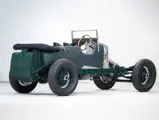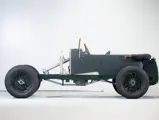British Classics Online
1930 Bentley 4½-Litre Supercharged Tourer 'Project' in the style of Vanden Plas
{{lr.item.text}}
€48,300 EUR | Sold
 | Netherlands
| Netherlands
{{internetCurrentBid}}
{{internetTimeLeft}}

- A rolling chassis project with correct modifications for accepting a supercharged 4½-Litre engine
- A fine platform from which to potentially build a ferociously quick ‘Blower’ specification Bentley
- Fitted with front and rear axles, a gearbox, and a reproduction body in the style of a Vanden Plas Le Mans Tourer
Bentley’s wonderful 4½-Litre was a hugely successful model for the marque, but Sir Henry ‘Tim’ Birkin believed that it could be improved. By using a supercharger designed by Amherst Villiers, forced induction increased both power and speed to an extent that the 4½-Litre Supercharged became one of the fastest cars in the world. Motorsport honours included breaking the lap record at the Circuit de la Sarthe during the 1930 edition of the 24 Hours of Le Mans.
This legendary model became better known as the ‘Blower Bentley’ and is arguably still the most famous car produced with a ‘winged B’ adorning the radiator. Despite the deceptively simple exterior appearance of the supercharger mounted proudly out front, the modifications required were quite substantial, particularly for the chassis. The front crossmember in the engine bay was no longer a flat-topped item but curved to allow fitment of the supercharger. At the front of the chassis, the supercharger was mounted to a crossbar which further required strengthening of the dumb irons.
According to Bentley service records, this Bentley, chassis number AD 3667, was built in April 1930 and first registered “GF 7581” in the UK before being immediately exported to Holland, with its first owner recorded as H.J.A. Van Heumen of Delft. A later period photo showed AD 3667 Bentley in a subtle specification, the wheels and rear surfaces of the headlamps were painted in green to match the desirable Vanden Plas Tourer body.
Registered by Van Heuman as “H.43353”, it is believed that he kept this Bentley until World War II. Little is known about the history of AD 3667 beyond this, although it is believed that the car was bought by John Hugenholtz, the famous race circuit designer and member of the Dutch resistance. During the later stages of the war, it is believed that AD 3667 disappeared, perhaps being requisitioned by retreating German forces or destroyed in bombing.
During modifications to bring a standard 4½-Litre to supercharged specification, as with the example here, the numbered dumb irons and front crossmember are lost. As a result, this Bentley 4½-Litre supercharged specification project is recognised by its numbered axles and steering box, all bearing the number “AD 3667”. It is unknown how this Bentley came to have these numbered parts, or if they originate from the Bentley that disappeared in the Netherlands in the 1940s. It is also fitted with an unnumbered D-type gearbox, which is likely to be a reproduction part, along with a reproduction body in the style of a Vanden Plas Le Mans Tourer. Other valuable parts include a cast aluminium bulkhead and fuel tank.
Ready to be turned into either a quick Blower Bentley to lead grids in vintage racing or as a versatile rally car, this 4½-Litre project modified to supercharged specification is a rare and exciting project.


















































